With so many rug sizes and styles available, it may be intimidating to choose one for your home. Area rugs have been called a room’s fifth wall, which means choosing the right one is as important and foundational as choosing the right wall color. Here’s a guide to choosing rug sizes that are a definite “design do” and will make a pleasing visual impact.
Living Room Rug Guide
Size matters when it comes to choosing living room rugs. Most rooms offer some flexibility, so the first thing to decide is your living room layout. If you’re on the fence about furniture placement, check out our living room layout guide.
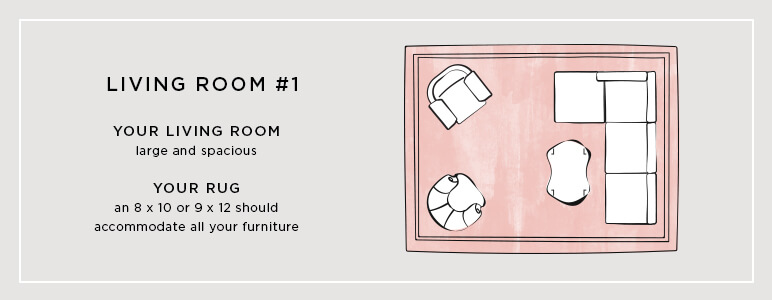

- If your room is large and spacious, like living room #1, you could choose a large area rug, such as 8′ x 10′ rugs or 9’ x 12′ rugs. Area rugs this size can usually accommodate all your furniture.
- If your living room is on the small side, like living room #2, choose a rug that is slightly smaller in scale and place just the front legs of your furniture on the rug. This creates a harmonious look and a cozy space, perfect for conversation. In this layout, the coffee table can play a starring role. To ensure you purchase just the right one, check out this coffee table dimension guide.
- This same concept can be used if you have an exceptionally large great room. Use two or more area rugs to visually break up the space, creating separate seating areas that will make the room more inviting. Just make sure each seating group complements each other in design, color and scale.
Dining Room Rug Guide
This is the one room where there isn’t a lot of flexibility in rug sizes. When it comes to choosing dining room rugs, the rules are very clear – it’s important that the table and chairs fit comfortably on top of it. The reason is as much for safety as for aesthetics – you don’t want your guests tripping over a too-short rug when they get up from the table. That means you should allow for at least 24 inches of room on all sides of the dining table. Measure your dining room table and add 24 inches (or more) on each side to find the correct measurement that will work for your room.

On a side note, if you’re wondering what size table you should have in your dining room in the first place, take a look at our dining table size and style guide.
Bedroom Rug Guide
There’s a lot more flexibility when it comes to choosing a rug for the bedroom, though most homeowners choose a bedroom rug that fits under the bed. You could choose a large rug that accommodates the entire bed and nightstands, or, as you see in bedroom #1, one that fits the bottom half of the bed and leaves the nightstands on the floor. Here are some general guidelines:

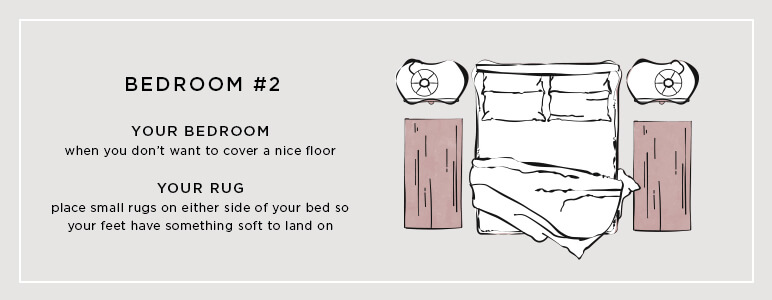
- 9’ x 12’ rugs will accommodate a queen or king bed, or two twin beds along with their nightstands and the bench or chest at the foot.
- 8’ x 10’ area rugs will hold a queen or king and nightstands, or, if positioned lower, will accommodate the bottom two thirds of the bed and leave nightstands on the bare floor.
- 6′ x 9′ area rugs will accommodate a single twin or full along with the nightstand and a bench or chest at the foot of the bed.
Of course, there’s no rule that says you must place an area rug under your bed. Take a look at bedroom #2. If you can’t bear the thought of covering gorgeous hardwood or tile floors, consider placing small area rugs on either side of the bed so your tootsies have something warm to land on when you wake up. And speaking of those tootsies…the bedroom is one place you’re guaranteed to be without shoes, so choosing the right type of rug material is exceptionally important here. Here is a rug construction guide if you’re unsure which rug material will work for you.
Hallway Rug Guide
Most standard hallway rugs are 2’ to 3’ wide, and anywhere from 6’ to 14’ long. No matter the size of your hall or entryway, you will ideally have from 4 to 5 inches of flooring visible on all sides of the rug, though more is acceptable, especially if the hall is very long. Just make sure rug placement is right in the middle of the hall for uniformity.
Kitchen Rug Guide
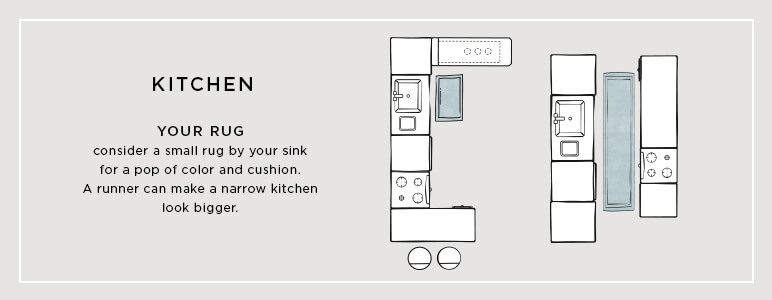
Things to keep in mind when choosing kitchen rugs:
- If you just want a pop of color or a little extra cushioning in the prep or sink area, consider a 3’ x 5’ area rug or 4’ x 6’ area rug.
- Narrow kitchens can benefit from a runner rug placed in the middle, which will make the room look bigger.
- For maximum impact, choose a large rug that complements the rest of the room. Just make sure there is between 6 and 24 inches between the rug and wall or cabinets and appliances.
Rug factors to consider:
Rug Fiber
Cotton – Cotton is a soft, natural fiber that’s used most often for casual or colorful rugs. It’s easy to clean and machine washable. They are best for casual spaces, such as a kid’s bedroom and kitchens.
Rug suggestion: Nuloom Hand Braided Tammara Rug
Jute – Jute is a natural fiber that’s used for textured or weaved rugs. It should avoid exposure to direct sunlight or moisture. The best place for these rugs is high-traffic sunny areas.
Rug suggestion: Nuloom Hand Woven Rigo Jute Area Rug
Synthetic – Synthetic fibers are less expensive alternatives for rugs. They’re made to be stain-resistant and water-repellent. Your hallways, the outdoors, or other high-traffic sunny areas would be best for synthetic rugs.
Rug suggestion: Nourison Passion Multicolored Bohemian Area Rug
Wool – Wool is a soft, durable fiber that naturally repels water and is easy to clean. It can be prone to shedding and fading over time. It’s best for high traffic areas such as living and dining rooms.
Rug suggestion: Safavieh Rectangular Rug
Polyester – Polyester is an extremely soft, easy-to-clean fiber that holds up to wear and tear. It repels water and most stains. High-traffic areas work best for polyester rugs, you can also use them outdoors to prevent tracking in dirt.
Rug suggestion: Modern Felicity Area Rug
Rug Pile Height
Rug pile are the loops woven into the rug’s backing. The rug pile height is the overall distance from the top surface of the loops to the backing of the rug. Knowing the different pile heights will help you choose the best rug for your space. Aside from pile height being an indicator of how the rug will feel under your hands and feet, it will also be an indicator on how hard or easy it will be to clean.
High Pile Height (1in. or higher) – best for rooms with low traffic, such as home offices or guest rooms. They are typically woven or tufted shag rugs. If you’re looking for a soft rug to walk on and a cozy aesthetic, this is the rug pile height for you.
Medium Pile Height (less than 1in.) – rooms with medium traffic like bedrooms or living rooms would be a good place for this pile height. They are typically woven, tufted cut or loop constructions. A medium pile height rug feels good on bare feet and are versatile to style.
Low Pile Height (Less than 0.5in) – are best for rooms with high traffic, like your hallways or kitchen. They are typically woven, tufted cut, or loop construction trimmed short. Low pile height rugs will wear more evenly and are easier to clean.
Flat Pile Height (Less than 0.025in.) – these types of rugs are best for high maintenance areas, such as playrooms or dining rooms. Typically are flatweave, natural fiber, or indoor-outdoor construction. Lastly, they are the easiest to vacuum and a low risk of tripping over them.
Rug Size FAQ
What are standard rug sizes?
- 2’ x 3’
- 4’ x 6’
- 5’ x 7’
- 5’ x 8’
- 6’ x 9’
- 8’ x 10’
- 9’ x 12’
- Runners
What are standard runner sizes?
- 2’ x 7’
- 3’ x 10’
- 3’ x 12’
How do you measure for a rug?
- First, measure the total width and length of your room, then measure all the large items that you plan to place in the room, such as the bed, sofa or dining table.
- Now, subtract the measurements of the area rug to find the exposed floor space. This will help determine if the space between the wall and the rug is appropriate for your layout.
Rug Size Guide Video
Click here to download our complete guide! You can also find more home decor inspiration by browsing our Pinterest boards.




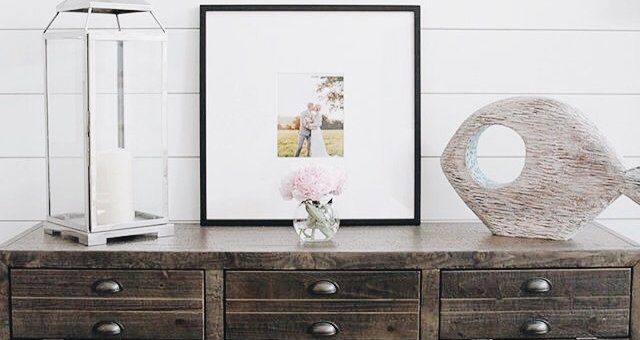
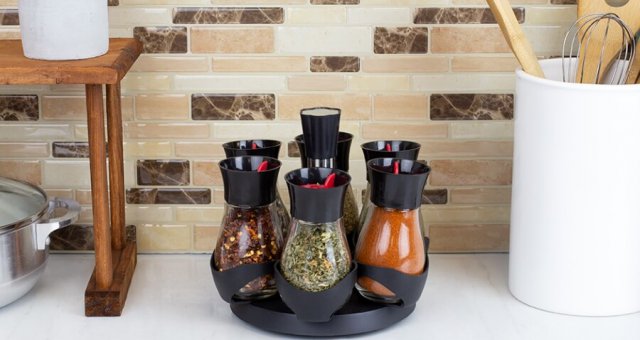
Do you carry indoor outdoor rugging? Also my porch 8’ by 9’ . I also need a runner for my garage but I haven’t measured that yet.
Hello! Yes we carry indoor/outdoor rugs on our website. You can find a style you love by visiting https://www.ashleyfurniture.com/c/rugs/indoor-outdoor/. Happy Shopping!
What color rug should use with ivory sofa and gray walls. Accent chair is navy blue?
Hello! We would recommend choosing a rug that has some neutral colors just like your walls and sofa (grays, creams, tans) and maybe even considering a rug that has a pop of blue! In our rug category we include filter functions for color to ease your selection. Happy shopping!
I need runner rug 3 x 10 how do i order one. Do you have any you can show on line.
Thanks
Hello! We do sell runner rugs on our website. You can find all of them linked here https://www.ashleyfurniture.com/c/rugs/all/runner_rugs/ They are also located under the RUGS tab and then Runner Rugs. Our runner rugs range in size. You will see the sizes are noted in the title. If a 3×10 runner rug is in stock for that style you will be able to purchase. We hope this helps!